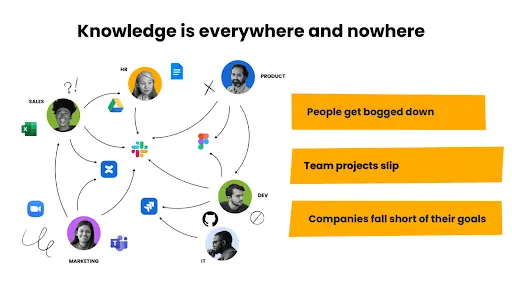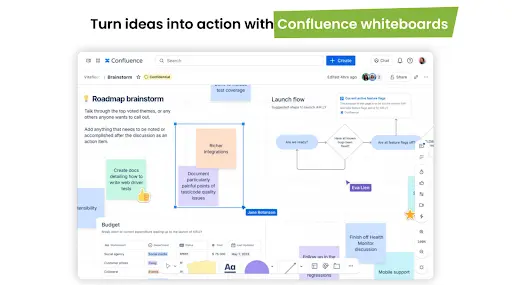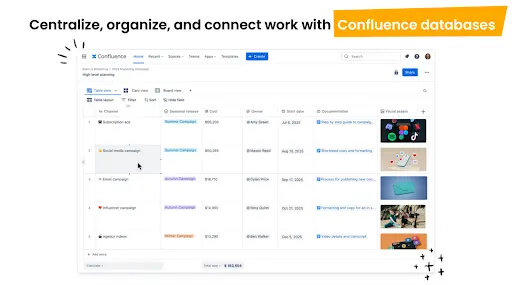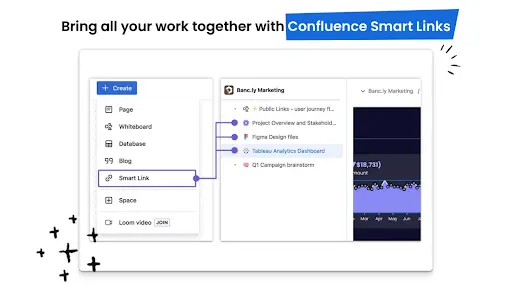Perché i team interfunzionali amano Confluence
When cross-functional projects fail, it’s usually not because teams aren’t working together — it’s because their tools aren’t. Product brainstorms happen in one place, marketing plans in another, and engineering tracks updates in a third. Somewhere between the Slack threads and the spreadsheets, things fall apart.
Work gets lost or duplicated, and deadlines shift. Eventually, teams lose sight of what they’re building and why.
Confluence brings order to that chaos. With tools like visual whiteboards, structured databases, Smart Links, and async Loom videos, cross-functional teams stay aligned — from kickoff to launch.
In this post, we’ll look at where collaboration tends to break down and how Confluence helps teams stay connected and moving forward.
Where cross-functional collaboration breaks down
Cross-functional teams succeed when they can move fast and stay aligned. But when every team brings its own tools, habits, and formats to the table, that alignment slips fast. Knowledge lives everywhere and nowhere all at once. Without one place to connect it all, collaboration turns into confusion.

Probabilmente l'hai provato in prima persona.
- Strumenti e sistemi non connessi: un team usa Asana, mentre un altro si affida a Google Docs. Un terzo condivide il feedback nei thread di Slack. E nella confusione si perde il contesto fondamentale.
- Caos legato alle versioni: in Google Drive ci sono vari file con diversi nomi, come "finale", "v2" e "finale-finale". I team non capiscono qual è la versione definitiva e da lì nascono gli errori.
- Mancanza di visibilità nei diversi team: il team di marketing è in attesa su una pagina di destinazione. Il team di prodotto non sapeva che la copia fosse pronta. Lavoro duplicato e tempistiche disallineate rallentano tutto.
Se manca l'allineamento, i team si imbattono in colli di bottiglia. Le tempistiche si allungano e le persone passano più tempo a cercare chiarezza che a svolgere un lavoro significativo. Anche le migliori idee possono bloccarsi prima di avere la possibilità di crescere.
Confluence: The tool that connects your team
This is where Confluence rewrites the playbook. Confluence gives cross-functional teams a shared space to plan, build, and move work forward — without the chaos of jumping between tabs and tools.
Start with a visual whiteboard to map out early ideas. Drop in sticky notes, draw connections, and add images. Use built-in AI to expand on rough concepts or spark new ones. As ideas take shape, shift seamlessly into execution.
Databases help structure the work: Create tasks, assign owners, and sort deliverables by campaign, deadline, or status. Whether your team prefers cards, boards, or lists, the work stays easy to track and update — no extra formatting required.
Need extra context? Smart Links embed docs or design files directly into your pages so everything’s accessible at a glance. And when you want to skip yet another meeting, record a quick Loom update and drop it right into the whiteboard or doc.
With everything connected, your team can stay in sync and keep projects moving without the usual blockers.
What cross-functional collaboration looks like in Confluence
So, what does all of this look like in action? Let’s walk through a typical product launch — before and after Confluence.
Before: Teams managed launches with a patchwork of disconnected tools. Ideas, drafts, and feedback circulated across emails and scattered documents. Teams worked in parallel but rarely in sync. As a result, context disappeared, and teams chased updates instead of doing the work.
After: Everything happens in one place. From first brainstorm to final review, every idea, asset, and update lives in a structured workspace built for cross-functional speed. Here’s how.
Turn ideas into action with Whiteboards
Before Confluence, early-stage planning meant chasing input across tools — stray Slack ideas and reference links lost in a doc somewhere. It was hard to capture momentum, let alone turn it into a plan.
Now, the project manager and product marketing lead open a shared Confluence whiteboard.

They brainstorm campaign themes and blog topics using digital sticky notes. Built-in AI helps them expand on half-formed thoughts and suggests new directions without leaving the canvas. To bring in context, they embed past launch materials as Smart Links: a high-performing campaign page, a customer quote, and a whitepaper from the archive. This gives the team a richer foundation to build from.
They prioritize ideas with a quick vote, sketch out rough next steps, and record a Loom video summarizing their thinking. Embedding it directly on the whiteboard gives every stakeholder the full backstory without needing another meeting.
Everyone walks away aligned — with clear priorities, shared context, and a plan they can actually build on.
Centralize and organize your work with Databases
With priorities in place, the product marketer meets with the head of content to turn ideas into deliverables.
Before, they tracked everything in a spreadsheet — and things got messy fast. Status updates went stale, links broke, and formatting was inconsistent. Without a central hub, deadlines were missed, and work had to be redone.
Now, they easily turn each approved idea into a Confluence database entry. The database becomes a live content tracker with key fields: asset type and owner, due date and status, and links to draft pages or supporting docs.

When it’s time to get to work, team members can generate Confluence pages directly from each database entry. Templates remove formatting guesswork and keep assets consistent.
Visibility improves instantly. When someone marks an asset page “Ready to review,” the status updates automatically in the tracker. Different views — boards for marketers, lists for PMs, card-style dashboards for leadership — make it easy for each team to scan what matters to them.
With one dynamic system of record, the team sees what’s in progress, what’s coming next, and who’s responsible. No status meeting needed.
Keep everything connected with Smart Links
After launch, the program manager leads a retrospective with all teams.
Before, pulling it together meant chasing down metrics in dashboards and digging through folders or emails for campaign files. The presentation took forever to create and the meeting took hours — half of it spent reorienting.
Now, it all lives in one place — a single Confluence page with Smart Links.

Everything’s embedded: the whiteboard from kickoff, the content database, key performance metrics, final designs, and a Loom walkthrough of the sales deck. Each item appears as an interactive Smart Link that everyone can hover to preview, click to open in full, or comment inline.
With key information at their fingertips, the team captures wins, logs lessons, and carries them into the next launch.
Confluence is for everyone
Confluence isn’t just for product launches. Any team juggling multiple tools and fast-moving projects can use it to work smarter.
Take HR, for example. Policy updates are often tracked in spreadsheets and announced across multiple channels. With Confluence, HR teams map out updates on whiteboards, assign reviewers in databases, and embed handbooks and training docs directly in one place — so everyone always sees the most current version.
Anche i team di marketing ne traggono vantaggio. Quando le campagne progrediscono velocemente, è importante essere allineati. Invece di gestire i brainstorming in uno strumento, i calendari in un altro e il monitoraggio delle prestazioni in un altro ancora, i team di marketing possono conservare tutto (dai brief creativi alle dashboard) all'interno di un unico spazio di lavoro condiviso.
I team di Customer Success possono utilizzare Confluence per documentare i playbook, tenere traccia dei problemi ricorrenti e assicurarsi che ogni cliente riceva un'esperienza coerente dall'onboarding al rinnovo. E i team legali possono usarlo per semplificare le revisioni delle politiche e centralizzare la documentazione, in modo che siano sempre disponibili le linee guida più aggiornate e chiare.
Indipendentemente dal reparto o dal risultato finale, Confluence offre a ogni team la struttura di cui ha bisogno per sostituire i flussi di lavoro obsoleti con sistemi puliti e scalabili.
Rendi più efficace il lavoro interfunzionale con Confluence
Il lavoro interfunzionale non è difficile perché i team non sono allineati, ma perché sono costretti a mettere insieme strumenti che non sono stati originariamente progettati per funzionare insieme.
Con Confluence, però, cambia tutto. I team hanno un'unica posizione per far progredire il lavoro, senza varie versioni diverse, problemi di controllo dello stato o perdite di tempo necessario per capire il contesto. I brainstorming portano direttamente ai risultati. L'avanzamento è visibile. Tutte le persone sono allineate.
Inizia a usare Confluence e Loom per allinearti più facilmente, produrre risultati più in fretta e completare il lavoro.
Scegli il tuo piano
Scopri i diversi piani disponibili in Confluence.
Panoramica di Confluence
Scopri che cos'è Confluence e se è una soluzione adatta al tuo team o alla tua organizzazione.